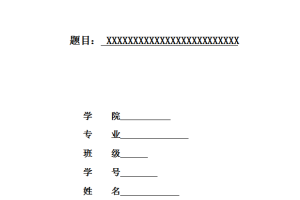多功能电子秤的设计
摘要:本设计以AT89S52单片机为核心,由称重传感器得到的被测物的重量将其变为线性电压模拟信号输出,然后通过放大器将信号放大。由A/D转换电路把放大的电压数值转换成相应的数字信号,转换后的数字信号通过AT89S52单片机的CPU进行处理,并且其他所需要的功能和各种接口电路也和CPU连接应用,然后通过单片机的显示器,将被测物的重量在显示器上显示出来。通过按键设置实现单价的功能,最终显示总价同时实现去皮等功能。为了使顾客更加了解购物清单,系统连接一个微型打印机将购物清单打印出来。因此这种电子秤的精确度更好操作简便等优点,为各个大、中、小型超市以及商场等带来很多的便利。成为人们日常生活中不可或缺的一部分,因此,多功能电子秤的设计和研究发展具有很大的现实意义。
关键字:AT89S52单片机;电子秤;称重传感器;A/D转换器
Design of Multifunctional Electronic Scale
Abstract: The design AT89S52 microcontroller as the core, by the weighing sensor of measured object weight will be the variable for linear voltage analog signal output, and then through the amplifier. The A / D conversion circuit to amplify the voltage value is converted into the corresponding digital signal, the converted digital signal by AT89S52 CPU, and other needs of function and several kinds of interface circuits also and CPU connected applications, then through the monitor SCM, will be measured weight shown on the display. Button to set the price to achieve the function, finally shows the price at the same time the peeled, etc. Function. In order to enable customers to better understand the shopping list, the system is connected with a micro printer will be shopping list print out. Therefore the electronic balance accuracy better operation convenient, for each big, medium and small supermarkets and shopping malls, etc. bring a lot of convenience. Be a part of an integral part of people’s daily life. Therefore, multifunctional electronic scale design and research and development has great practical significance.
Keywords:AT89S52 single chip microcomputer; electronic scale; weighing sensor; A/D converter
目 录
1.2 电子秤的发展与现状………………………………………. 1
1.3 电子秤的智能化………………………………………….. 2
第2章 总体方案的设计………………………………………….. 4
2.1 设计电子秤的指导思想…………………………………….. 4
2.2系统的总体设计方案与论证…………………………………. 4
第三章 系统硬件设计……………………………………………. 7
3.2 系统电源……………………………………………….. 8
3.3 A/D转换器…………………………………………….. 10
3.3.1 AD转换电路……………………………………….. 13
3.4 AT89S52控制电路……………………………………….. 14
3.5 74ALS373介绍………………………………………….. 17
3.6 62256存储器简介……………………………………….. 18
3.6.1 62256简介………………………………………… 18
3.6.2 62256存储电路…………………………………….. 19
3.7 人机交互部分…………………………………………… 19
3.7.1 键盘输入…………………………………………. 19
3.7.2 ZLG7289简介………………………………………. 20
3.7.3 ZLG7289引脚及简介…………………………………. 20
3.7.4 ZLG7289控制电路…………………………………… 21
3.8 12864 LCD显示电路……………………………………… 21
3.8.1 12864简介………………………………………… 22
3.8.2 12864引脚及简介…………………………………… 23
3.8.3 12864显示电路图…………………………………… 23
3.9 打印机接口电路…………………………………………. 24
3.9.1 MAX232简介……………………………………….. 24
3.9.2 打印机接口电路……………………………………. 24
3.10 报警电路……………………………………………… 25
第四章 软件设计………………………………………………. 26
4.1 数字滤波技术…………………………………………… 26
4.2 线性化处理技术…………………………………………. 26
4.3 主程序流程图…………………………………………… 27
4.4 中断服务程序流程图……………………………………… 28





